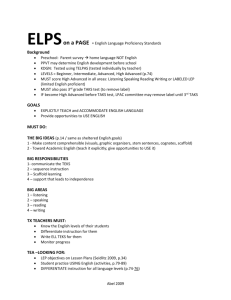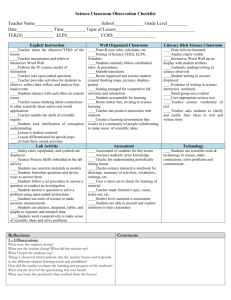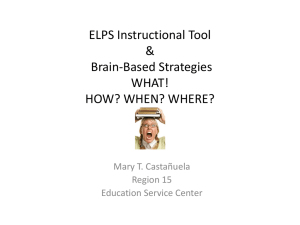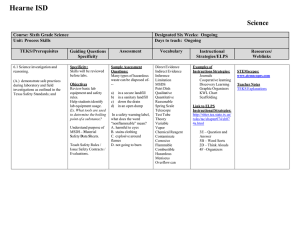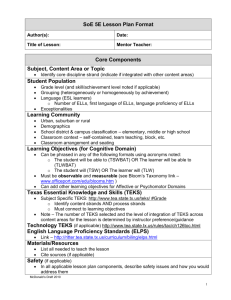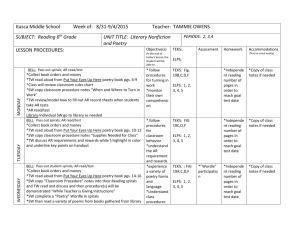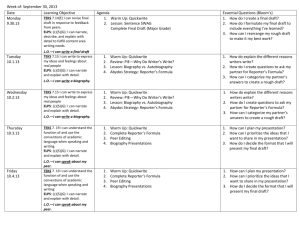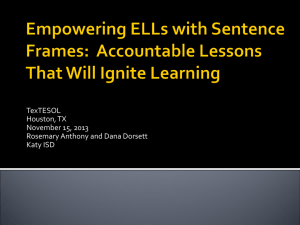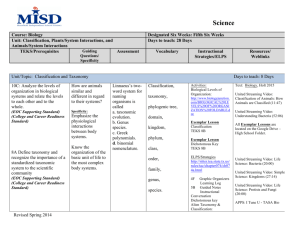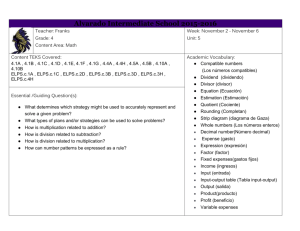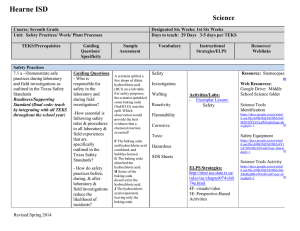ELPS on one PAGE = English Language Proficiency Standards
advertisement
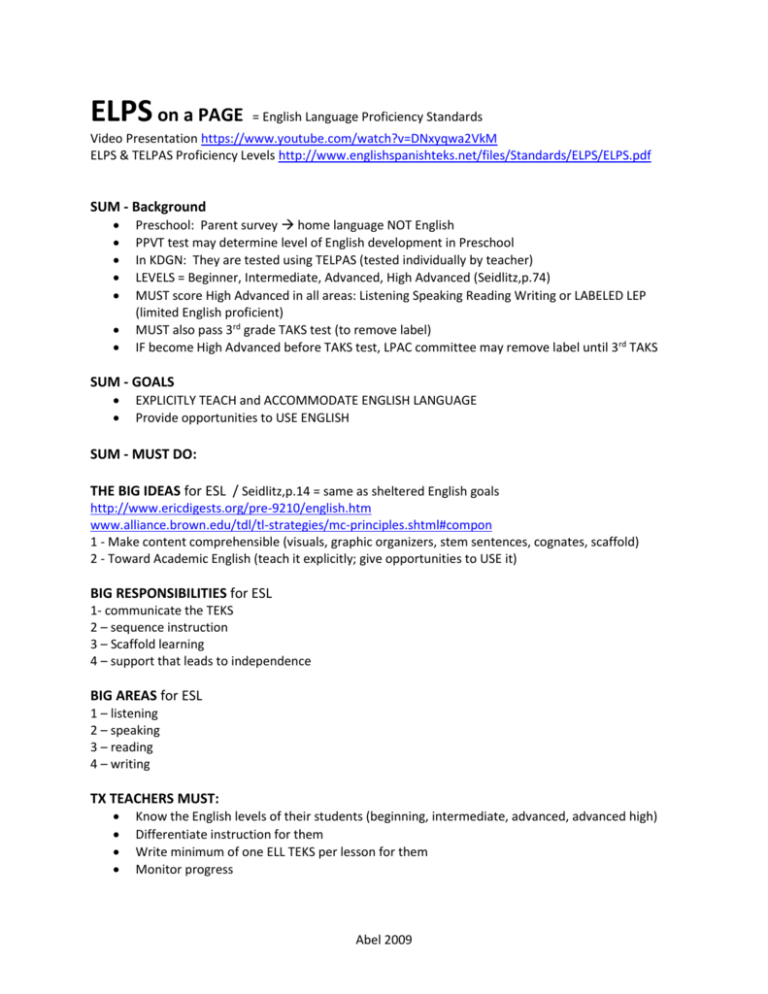
ELPS on a PAGE = English Language Proficiency Standards Video Presentation https://www.youtube.com/watch?v=DNxyqwa2VkM ELPS & TELPAS Proficiency Levels http://www.englishspanishteks.net/files/Standards/ELPS/ELPS.pdf SUM - Background Preschool: Parent survey home language NOT English PPVT test may determine level of English development in Preschool In KDGN: They are tested using TELPAS (tested individually by teacher) LEVELS = Beginner, Intermediate, Advanced, High Advanced (Seidlitz,p.74) MUST score High Advanced in all areas: Listening Speaking Reading Writing or LABELED LEP (limited English proficient) MUST also pass 3rd grade TAKS test (to remove label) IF become High Advanced before TAKS test, LPAC committee may remove label until 3rd TAKS SUM - GOALS EXPLICITLY TEACH and ACCOMMODATE ENGLISH LANGUAGE Provide opportunities to USE ENGLISH SUM - MUST DO: THE BIG IDEAS for ESL / Seidlitz,p.14 = same as sheltered English goals http://www.ericdigests.org/pre-9210/english.htm www.alliance.brown.edu/tdl/tl-strategies/mc-principles.shtml#compon 1 - Make content comprehensible (visuals, graphic organizers, stem sentences, cognates, scaffold) 2 - Toward Academic English (teach it explicitly; give opportunities to USE it) BIG RESPONSIBILITIES for ESL 1- communicate the TEKS 2 – sequence instruction 3 – Scaffold learning 4 – support that leads to independence BIG AREAS for ESL 1 – listening 2 – speaking 3 – reading 4 – writing TX TEACHERS MUST: Know the English levels of their students (beginning, intermediate, advanced, advanced high) Differentiate instruction for them Write minimum of one ELL TEKS per lesson for them Monitor progress Abel 2009 TEA –LOOKING FOR: LEP objectives on Lesson Plans (Seidlitz 2009, p.34) Student practice USING English (activities, p.79-89) DIFFERENTIATE instruction for all language levels (p.74-76) LANGUAGE LEVELS expected at the student’s grade level (p. 74) BEGINNER INTERMEDIATE ADVANCED HIGH ADVANCED How to support (p. 75) LISTENING SPEAKING READING WRITING Modify language w short simple word’d, enunciate Does not seek help Key word support Stud. seeks help Single words Short phrases Errors, pronuncia Environmental print, visuals, Word word word Simple message Basic vocabulary Understood Complex sentences w pauses, restates Abstract, native Slow, rereads Pretaught vocab Not grade level High comprehend Some voc support No focus High frequency words, present tense, errors Familiar topics, present tense, errors Emerging grade appropriate vocab, support ideas Content w little support, native Understands w Visuals, wait time Talk slowly Native speaker Grade level, native LESSON PLAN example CO (content objective / from TEKS) SE expected to identify the states of matter LO (language objective / from 45 expectations on p.34) 4E – LEP SE read simplified text about states of matter w word bank picture cards Summarized, p.33. LO TEKS for LEP students: strategies to ask for help (T provide sentence cards) speak in complete sentences (T provide sentence stems) teacher will randomize when calling on students /will wait & support (use rotation, sm gps) to use response signals when know/don’t know answer (hand open = know answer; fist, not) teacher will use visuals and build PK and vocabulary use strategies during supported/adapted reading (adapt text, comp strategies) participate in structured conversation & writing (think-pair-share) LEARNING STRATEGIES p. 41 – 59 1 = learning strategies for the student to use 2 = listening 3 = speaking 4 = reading 5 = writing _______________________ Source: Navigating the ELPS: Using the New Standards to Improve Instruction for English Learners 2nd Edition (Version 2) by John Seidlitz, Educational Consultant., 2008. Canter Press, 10926 Colt Chase; San Antonio, TX 78254. Abel 2009 Speaker: Angel Torres, Director McAllen I.S.D. Bilingual, English as a Second Language (ESL), and Newcomer Academy programs. Presentation, Navigating ELPS, at the Project ENLACE English Language Learner Leadership Institute at Stephen F. Austin State University’s James I. Perkin’s College of Education, September 25, 1009. LO TEKS for your lesson plans (summarized / the gist) Learning Strategies: 1A – Use PK to understand 1B – Self Monitor 1C – Use strategies to acquire Vocabulary 1D – Use diff. strategies when exact English word is unknown LANGUAGE OBJECTIVES – LISTENING LANGUAGE OBJECTIVES – SPEAKING 2A – SE recognize: correct pronunciation 2B – recognizes: sounds in words (ph.awareness) 2C – recognize: words/phrases in discussion 2D – understand or seek help 2E – use visual / context in spoken language 2F - use technology to learn / review 2G – gist, main points, details 2H – implied info 2I – listening comprehension 3A – correct pronunciation of words ____ 3B – use new vocabulary about topic 3C – use variety of sentence stems 3D – speak using newly taught vocab _____ 3E – share in cooperative groups about ____ 3F – ask / give info using words ____ 3G – give opinions about ___ using words, phrases 3H – narrate, describe, explain 3I – use in/formal English to say____ 3J – oral response to variety of media about____ LANGUAGE OBJECTIVES – READING LANGUAGE OBJECTIVES – WRITING 4A – letter-sounds & phonics 4B – directionality 4C – sight vocabulary 4D – BEFORE reading support 4E – simplify text (to access content) 4F – pictures / semantics to support reading (predictable text) 4G – show comprehension individually or in groups 4H – demonstrate compreh. of text read silently 4I – develop basic reading skills that build compreh 4J – make inferences about text & graphics 4K – analyze text 5A – use letter-sounds, phonics 5B – use new vocabulary 5C – spell correctly 5D – Edit writing 5E – simple & complex sentences 5F – use sentence frames & selected vocabulary 5G –narrate, describe, and explain in writing THE LIST http://ritter.tea.state.tx.us/rules/tac /chapter074/ch074a.html#74.4 Abel 2009 WHY are we doing this? English Language Learners (ELL) are the fastest growing population in our schools. This poses challenges for educators, especially in Texas kindergarten classrooms where these populations are increasing most rapidly (Fry & Gonzales, 2008). With over 400 language variations spoken in our schools across the U.S. (Pew Census 2006), bilingual education is not always an option. Half of these children live in poverty. A low Socioeconomic status (SES) often contributes to lack of school success which in turn can be explained by limited early language development support from the home (Hart & Risley, 2003). It becomes important to influence language development which is the foundation for future learning and success in school (National Research Council, 1999). Among the most important variables found to support ELLs include a quality teacher in the classroom, strong home support, and a good foundation in the first language (Ramirez Report). Young ELLs face increased risk for school failure due to the lack of teachers who are knowledgeable about second language development in children (Coppola, 2005) The Ramirez Report and other studies (e.g., Cazden, l984) note that the quality of student and teacher interaction is critical in improving language development and that the most important skill teachers can utilize even over knowing how to speak the child’s language is to learn how language works (Texas Demographics, Searchlight.org). Language develops best in a rich environment with opportunities to use language (Dickinson, 2001) Children who are exposed to an environment rich in language and able to interact with adults using language in a social context develop a greater facility with language than those who are not afforded such opportunities (Morrow, Strickland, & Woo, l998; Cazden, 2005; Dickinson, McCabe, & Essex, 2006; Gaskins, 2003; Morrow, 2005; Morrow, Kuhn,& Schwanenflugel, 2006). Abel 2009
